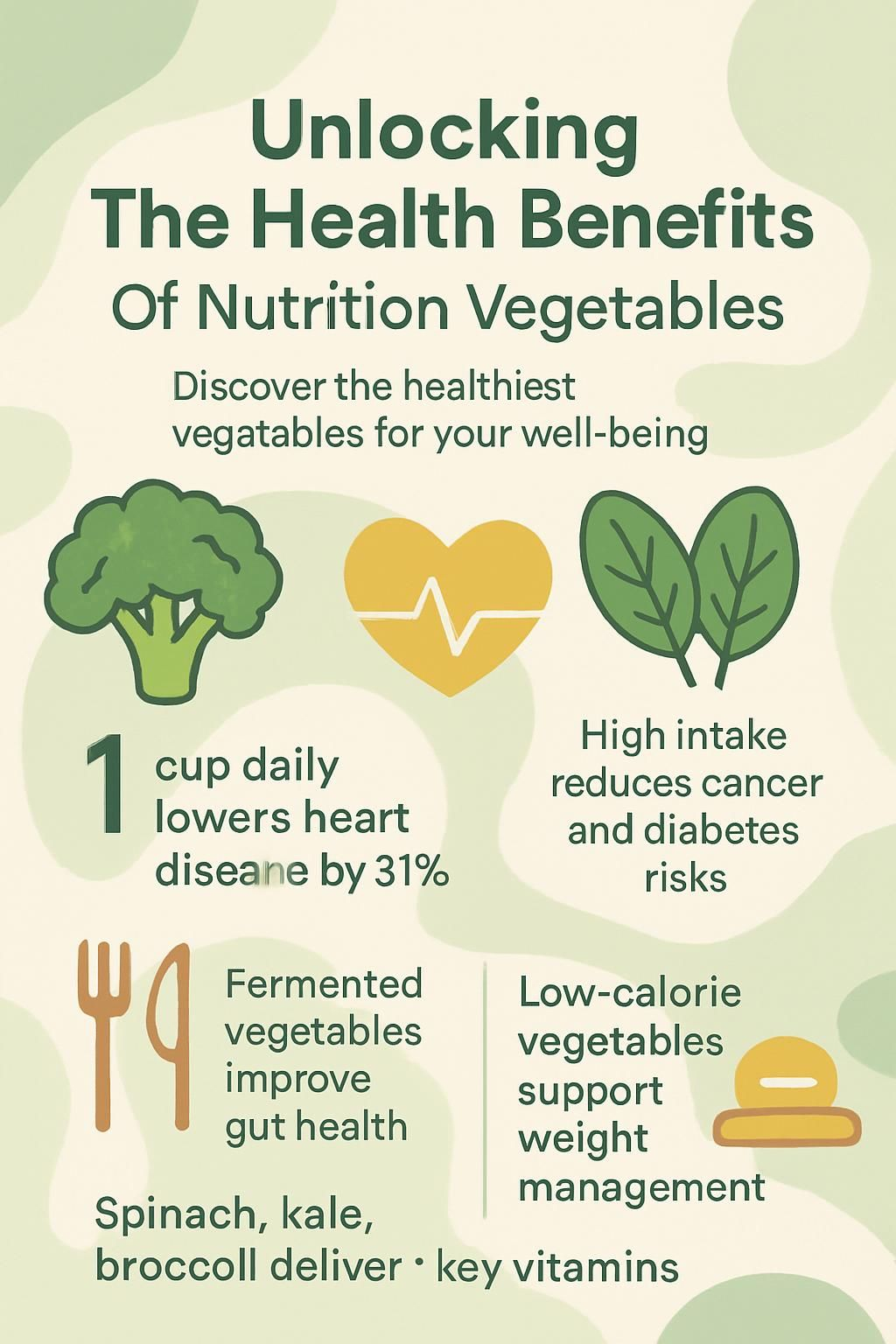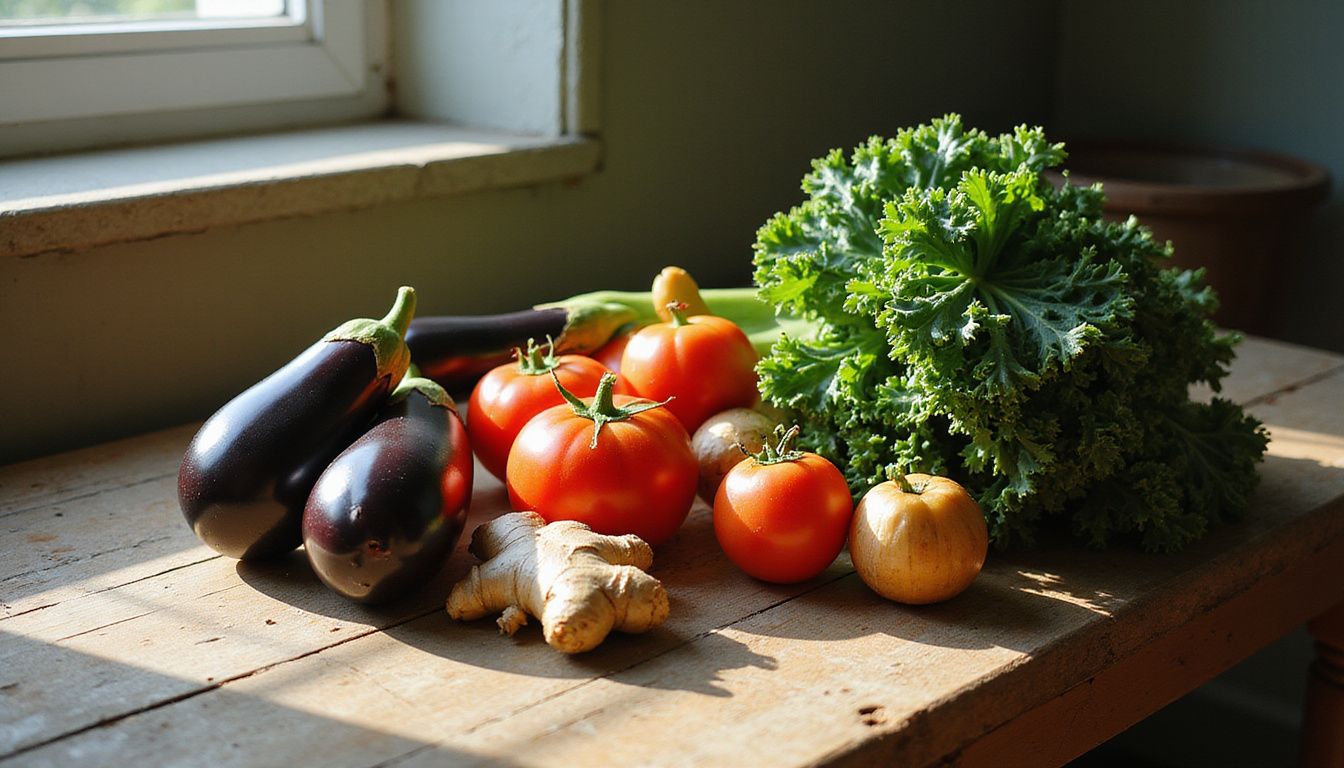Unlocking The Health Benefits Of Nutrition Vegetables: Discover The Healthiest Vegetables For Your Well-being
Our Nutrition Assistant AI Suite will transform your body. You will lose fat, get toned, and build muscle. Gain confidence and optimal health.
Low energy or sluggish days often trace back to what lands on your plate. The health benefits of vegetables are real, and they touch almost every system in your body. Vegetables supply vitamins, minerals, dietary fiber, and antioxidants that help you feel and function better.
This guide explains the health benefits of vegetables and spotlights the healthiest vegetables to add now. You will see simple ways to include a variety of vegetables each day so your well-being improves bit by bit.
Key Takeaways
- Vegetables such as spinach, kale, broccoli, carrots, and sweet potatoes deliver vitamins A, C, and K, plus potassium, fiber, and protective antioxidants.
- At least 1 cup of nutrient-dense vegetables daily is linked with lower blood pressure and cholesterol, and up to a 31 percent drop in heart disease risk.
- Large studies, including the Nurses’ Health Study, associate higher vegetable intake with reduced risks of cancer, type 2 diabetes, stroke, and other chronic illnesses.
- Fermented vegetables, such as sauerkraut, add probiotics that support gut health. Raw and cooked vegetables supply fiber that improves digestion and fullness.
- Because vegetables are low in calories and high in nutrients, regular intake supports weight control, immune function, and steady energy.

Why Are Vegetables Essential for Health?

Vegetables fill nutrition gaps that many diets have. Eating a mix of vegetables each day supports long-term health and steady performance in daily life.
What nutrients make vegetables important for health?
Key nutrients include potassium, vitamin K, vitamin A, vitamin C, fiber, magnesium, folate, and antioxidants. Antioxidants are compounds that protect your cells from damage by unstable molecules called free radicals.
Leafy greens like spinach and kale are rich in vitamins A and C. Sweet potatoes supply potassium and beta carotene, which your body converts to vitamin A. Many non-starchy vegetables, such as carrots, offer 2 or more grams of fiber per serving, which supports regular digestion.
Swiss chard and broccoli contribute folate and magnesium for muscle and heart function. Potassium is widely available in beans, beet greens, soybeans, lima beans, tomato products, kidney beans, acorn squash, kohlrabi, and yuca. Potassium helps manage blood pressure.
Cruciferous vegetables, including broccoli and cauliflower, contain phytochemicals, which are plant compounds that may lower the risk of certain cancers. Dark green leafy vegetables add powerful antioxidants that help protect cells from damage due to stress or pollution.
Eating at least one cup of nutrient-dense vegetables each day supports heart health and lowers disease risk.
How do vegetables help prevent diseases?
Vegetables protect you in several ways. Leafy greens such as spinach and kale provide vitamin A, which supports healthy eyes, skin, and immunity. Broccoli delivers plant compounds called indoles and isothiocyanates that may reduce cancer risk.
Carrots supply beta carotene for vision and immune support. Diets high in vegetables can lower cholesterol because fiber helps remove it from the body. In the Nurses’ Health Study, higher intake of fruits and vegetables was linked with fewer heart problems.
Foods rich in potassium, like beets and sweet potatoes, help control blood pressure and may lower stroke risk. Bright vegetables such as red cabbage and bell peppers offer phytochemicals that reduce oxidative stress, a factor linked with diabetes and some cancers.
How do vegetables contribute to overall well-being?
Vegetables and fruit energize your day with vitamins, minerals, and antioxidants. These nutrients support your immune system and help calm inflammation, which is your body’s response to injury or stress.
Leafy greens and orange vegetables help with weight control because they are low in calories and fat. Fiber from vegetables supports healthy digestion and steadier blood sugar levels.
Eating several servings of vegetables lowers the risk of chronic conditions such as cardiovascular disease, type 2 diabetes, stroke, and some cancers. Nutrients like potassium, calcium, iron, polyphenols, nitrates, lycopene, and vitamin C support strong bones and healthy nerves. Polyphenols are plant compounds that act as antioxidants, and nitrates in some vegetables support blood flow.
Key Nutrients Found in Vegetables
Vegetables pack vitamins and minerals that your body uses for growth, repair, and energy. A mix of choices each day can raise your vegetable intake and strengthen your diet.
What vitamins are abundant in vegetables?
Many vegetables provide high amounts of essential vitamins in a single serving. Here are standouts:
- Leafy greens such as spinach and kale are rich in vitamin K, often exceeding your daily need in 1 cup.
- Carrots deliver more than four times the daily vitamin A requirement per cup for eye health.
- Bell peppers supply around 190 mg of vitamin C per cup, which supports immunity and skin.
- Swiss chard offers vitamins K, A, and C in one cup to help keep your defenses strong.
- Broccoli provides vitamin K and vitamin C per cup to support bones and immunity.
- Sweet potatoes deliver over 100 percent of daily vitamin A and about 25 percent of vitamin C in one medium potato.
- Beets add folate, which supports cell growth and is vital during pregnancy.
- Juices from citrus fruits, such as orange juice, can add vitamin C; whole fruits still offer more fiber.
Adding a colorful salad with dark greens and peppers to lunch can steady energy for the rest of the day.
Which minerals do vegetables provide?
Vitamins often get attention, yet minerals are just as important. They support bones, muscles, nerves, and heart rhythm. Common vegetable sources include:
- Spinach, which supplies calcium, magnesium, and iron for bone and muscle function.
- Beets, which provide about 442 mg potassium per cup for fluid balance and blood pressure.
- Asparagus, which offers potassium and works well in salads or grain bowls.
- Broccoli, which contributes potassium along with smaller amounts of calcium and magnesium.
- Onions, which supply manganese, a helper mineral for enzyme and metabolic activity.
- Cabbage, which contains potassium and magnesium for muscle and nerve function.
- Swiss chard, which is rich in iron and magnesium, a helpful addition for plant-forward diets.
- Kale, another leafy choice that provides calcium to support bone health.
How does fiber in vegetables benefit digestion?
Fiber keeps your digestive system moving. Brussels sprouts, peas, and cauliflower are reliable sources. One cooked cup of peas has about 9 grams of fiber. A cup of cauliflower adds bulk that helps you approach the recommended 25 to 30 grams per day. A 2022 review supports this target for better health outcomes.
Fiber helps you feel full, supports healthy gut bacteria, steadies blood sugar, and lowers LDL cholesterol. These effects reduce heart disease risk over time. Choosing vegetables such as broccoli and legumes like peas can make day-to-day digestion smoother and more comfortable.
What antioxidants and phytochemicals are in vegetables?
Beyond fiber, vegetables provide antioxidants and phytochemicals, which are protective plant compounds. Broccoli contains indoles and isothiocyanates that may help lower cancer risk. Carrots are rich in beta carotene for eye and immune health.
Tomatoes deliver lycopene, lutein, and zeaxanthin, all of which help protect your eyes and cells. Cauliflower offers sulforaphane, a compound studied for its anti-cancer potential.
Garlic contains allicin, which has broad health effects in research. Onions deliver sulfur compounds that have been linked with protection against certain cancers in systematic reviews. Red cabbage contains anthocyanins, a group of pigments with strong antioxidant actions. Adding a handful of broccoli florets or spinach to soup is an easy way to raise your daily intake.
The Healthiest Vegetables to Include in Your Diet
Some vegetables give you more nutrition per bite. The vegetables below are frequent study winners and make great staples in a weekly plan.
Spinach
Spinach delivers key vitamins with very few calories. One cup of raw spinach has about 7 calories and provides vitamins K, A, and C along with magnesium, folate, and iron. Vitamin K supports bone health and normal blood clotting.
If you take blood thinners such as warfarin, keep your vitamin K intake steady and speak with your healthcare provider. Eating spinach raw preserves many nutrients, and lightly cooking can improve the absorption of some minerals.
Add spinach to salads, omelets, soups, and smoothies to raise daily vegetable servings. Its fiber supports appetite control and may help lower the risk of heart disease and type 2 diabetes over time.
Kale
Kale is another leafy green with high nutrition and few calories. It provides vitamins A, C, and K, which support immunity, skin, and bones. In one study, people who consumed kale powder showed improved cholesterol profiles, suggesting better heart health.
If you use blood thinners, watch your intake because vitamin K can interfere with medication. Enjoy kale raw in salads and smoothies or bake kale chips for a crunchy snack. Some people also blend kale with beet or mustard greens, such as Brassica juncea, for variety.
Broccoli
Broccoli gives you vitamin K and vitamin C for very few calories. It also contains plant chemicals called indoles and isothiocyanates that have been studied for cancer protection.
Roast, steam, or stir-fry broccoli with a pinch of salt and pepper. Add it to soups and salads for texture and fiber. Building meals with fresh vegetables such as broccoli can help you eat fewer refined carbohydrates and feel satisfied.
Carrots
Carrots are low in calories and high in beta carotene, which converts to vitamin A. One cup offers more than four times your daily vitamin A need, which helps protect vision and supports immune function.
Research links higher carrot intake with a reduced risk of some cancers, including breast cancer. Carrots are easy to enjoy raw with dip, roasted, or cooked into stews and stir-fries.
Sweet Potatoes
Sweet potatoes offer more than 100 percent of your daily vitamin A in one medium potato. They also provide vitamin C, vitamin B6, and potassium with about 103 calories.
They have a lower glycemic index than many other starchy foods, which means steadier blood sugar for most people. Bake or roast them in the skin for more fiber. Pair with fish or beans for a balanced, filling meal.
Garlic
Garlic adds big flavor and helpful plant compounds while adding very few calories. Allicin, formed when garlic is chopped or crushed, is linked with heart and immune benefits in research.
Raw garlic keeps more allicin than cooked versions. Add minced garlic to salads, dips, and dressings, then use cooked garlic in soups or sautés for a gentler taste.
Beets
Beets are rich in potassium and folate and are a natural source of dietary nitrates. Nitrates support blood vessel function, which may help lower blood pressure.
Beets can be roasted, added to salads, or blended into smoothies. Some studies suggest that compounds in beets may help people with nerve symptoms related to diabetes. Their color also brightens meals, which can encourage you to eat more vegetables.
Brussels Sprouts
Brussels sprouts are high in vitamins C and K and deliver fiber that supports digestion. Folate supports cell growth and is important during pregnancy.
Roasting brings out a nutty flavor that many people enjoy. Regularly including Brussels sprouts has been associated with lower chronic disease risk in population studies of green leafy vegetables.
Peas
Peas give you fiber and protein in the same bite, which helps with fullness. One cooked cup provides about 9 grams of each, plus vitamins A, C, K, and B vitamins.
They are a smart choice for vegetarian or vegan meals. Saponins in peas are plant compounds studied for potential anti-cancer actions. Add peas to soups, salads, and grain bowls for extra texture and staying power.
Swiss Chard
Swiss chard is a colorful leafy green that is low in calories yet high in vitamins K, A, and C. It also contains magnesium, which supports muscle and nerve function.
Sauté Swiss chard with garlic and olive oil or add it to soups and pasta dishes. Its mild flavor helps you reach daily vegetable goals without much effort.
Asparagus
Asparagus is a light choice that brings vitamin K, vitamin A, and folate. It also contains antioxidants such as glutathione, which helps protect cells.
Roast or steam asparagus and finish with lemon juice and olive oil. Add to salads, omelets, or grain bowls for a quick nutrient boost.
Red Cabbage
Red cabbage is rich in vitamins C and K and contains anthocyanins, the pigments that give it a deep purple color. These antioxidants support cell protection and may calm inflammation.
Fermented red cabbage, like sauerkraut, adds probiotics that support a healthy gut. Toss raw red cabbage into slaws and salads for crunch and color.
Bell Peppers
Bell peppers deliver a large dose of vitamin C with very few calories. They also provide vitamin B6, folate, and beta carotene for heart and eye health.
Enjoy them raw with hummus, roasted on a sheet pan, or sliced into stir-fries. Adding peppers to salads is an easy way to raise your vegetable intake.
Health Benefits of Vegetables
Vegetables work like a daily health shield. A colorful mix supports your heart, gut, and immune system while helping with weight control.
How do vegetables improve heart health?
Beets supply nitrates that help relax blood vessels, which supports healthy blood pressure. Sweet potatoes add potassium that also helps control blood pressure.
Fiber-rich vegetables such as peas lower LDL cholesterol, a major heart risk factor. Diets high in vegetables are linked with fewer heart problems across many population studies. Fermented vegetables like sauerkraut may aid heart health through a healthier gut, which can reduce inflammation tied to vascular disease.
What role do vegetables play in digestion and gut health?
Vegetable fiber adds bulk, which helps keep you regular. Brussels sprouts and cauliflower are helpful choices for this reason. Beans, peas, and lentils provide both fiber and protein, which support fullness and gut function.
Fermented vegetables such as sauerkraut and pickles add probiotics, the “good” bacteria. Probiotics can ease some digestive symptoms, including IBS and diarrhea. Studies suggest fermentation keeps many nutrients available, which adds value to these foods.
How can vegetables reduce chronic disease risk?
Eating a variety of vegetables is linked with lower risk of cancer, diabetes, and stroke. Cruciferous vegetables, such as broccoli and cauliflower, supply compounds like sulforaphane, which may inhibit cancer cell growth.
Onions and garlic contain sulfur compounds studied for cancer protection. Higher carrot intake has been associated with lower breast cancer risk in a major review. Plant fiber improves blood sugar control, which supports prevention of type 2 diabetes.
How do vegetables strengthen the immune system?
Vegetables deliver vitamins that help immune cells work well. Broccoli and bell peppers are excellent sources of vitamin C. Carrots add vitamin A, which supports the lining of your skin and gut, key barriers against infections.
Leafy greens, such as spinach and Swiss chard, offer vitamins K, A, and C plus antioxidant support. Red cabbage adds extra vitamin C and anthocyanins that help reduce oxidative stress. A plate filled with different colors helps your immune system respond quickly to threats.
Can vegetables help with weight management?
Low-calorie vegetables like spinach, kale, and asparagus help you manage daily calories while eating larger, satisfying portions. One cup of raw spinach has about 7 calories, and a cup of raw kale has about 7 calories.
Fiber-rich choices such as peas and Brussels sprouts promote fullness. This reduces the urge to snack soon after meals. Many people find that adding a big serving of greens at lunch helps prevent afternoon cravings.
Studies associate regular vegetable consumption with a lower risk of overeating higher calorie foods.[1]
[1] Statistical data from USDA FoodData Central
How to Incorporate More Vegetables into Your Diet
Small steps work best. Focus on adding one extra serving at a time, then build from there.
How can I include raw and cooked vegetables daily?
At breakfast, add raw spinach, tomatoes, or sliced carrots to an omelet or wrap. For lunch, make half your plate a salad of raw leafy greens like romaine or kale. Two cups of raw leafy greens count as one cup toward your daily goal.
For dinner, steam broccoli or Brussels sprouts to keep antioxidants high. Roast sweet potatoes in their skins for more fiber. Bake potatoes instead of frying to cut added fat. Add cooked garlic or beets to stir-fries and soups to raise vitamins and minerals. Keep cut bell peppers ready for quick snacks.
Prepping a tray of roasted vegetables on weekends makes healthy choices easier on busy days.
What are some ways to add vegetables to smoothies and soups?
Blend spinach, kale, or carrots into smoothies. Their flavor is mild once you add fruit. Swiss chard also blends well and adds vitamins K and A.
For soups, include broccoli, cauliflower, bell peppers, and tomatoes. These upgrades raise vitamins, fiber, and protective plant compounds. Even a single serving of leafy greens each day is linked with better heart health in recent research.
How do fermented vegetables support gut health?
Fermented vegetables such as sauerkraut, pickles, carrots, and cauliflower provide probiotics, the live bacteria that support your gut microbiome. A healthy gut helps with digestion and nutrient absorption.
These foods keep most of their vitamins and minerals after fermentation. Eating them often can ease diarrhea risk and may help with IBS symptoms. Regular intake supports a balanced gut environment linked with better long-term health.
What are easy vegetable snacks and side dishes?
For quick snacks, choose bell pepper strips, carrot sticks, celery sticks, cucumber slices, or broccoli florets. Pair with hummus or yogurt dip for extra protein.
Roasted Brussels sprouts or cauliflower make simple, high-fiber side dishes. Add alfalfa sprouts to sandwiches for a light nutrient lift. Keeping washed, cut vegetables at eye level in the fridge makes healthy snacking more likely.
Tips for Maximizing Nutritional Benefits
Smart picking, storing, and cooking help you keep more nutrients on the plate. A few simple habits make a real difference.
Why choose fresh and seasonal vegetables?
Fresh, in-season vegetables are often harvested at peak ripeness, so they hold more vitamins and taste better. For example, spinach can lose a large share of vitamin C within a week of storage, which is why fresher options can be more nutritious.
Seasonal produce often has better texture and color, which makes salads and cooked dishes more appealing.
How should vegetables be stored to keep nutrients?
Store vegetables cold to slow nutrient loss. Leafy greens hold vitamins longer when sealed in airtight containers with a dry paper towel to absorb moisture.
Use perforated bags for broccoli, carrots, and bell peppers to hold some moisture without trapping too much. Keep your fridge at 34 to 40 degrees Fahrenheit. Freeze vegetables soon after purchase if you will not use them in a few days. Frozen peas and mixed vegetables can equal or exceed the nutrients of produce kept at room temperature for several days.
Wash vegetables right before eating. Washing too early can speed spoilage. Properly canned or dried vegetables keep well when stored in sealed containers away from light.
How can I avoid overcooking vegetables?
Steam or roast vegetables briefly. Most vegetables need only 3 to 8 minutes of steaming. Short cooking helps preserve vitamin C and other antioxidants. Boiling can cause large nutrient losses, especially for vitamin C.
Use a timer and test tenderness with a fork. Vegetables should be crisp-tender, not mushy. Light sautéing or quick roasting builds flavor while protecting more nutrients, especially in spinach, carrots, and broccoli.
Daily Recommendations for Vegetable Intake
Meeting daily goals is easier if you count cups across meals and snacks. Build variety over the week so you cover all subgroups.
How much vegetable intake is recommended daily?
Daily needs vary by age and gender:
- Toddlers 12 to 23 months: about 1/2 to 1 cup per day
- Children 2 to 3 years: 1 to 1.5 cups per day
- Children 4 to 8 years: 1 to 2 cups per day
- Girls 9 to 13 years: 1.5 to 3 cups per day
- Girls 14 to 18 years: 2 to 3 cups per day
- Boys 9 to 13 years: 2 to 3 cups per day
- Boys 14 to 18 years: up to 4 cups per day
- Women 19 and older: about 2 to 3 cups per day
- Men 19 to 59 years: about 3 to 4 cups per day
- Men 60 and older: about 2.5 to 3.5 cups per day
These serving sizes align with U.S. Department of Agriculture guidance. Eating a variety of vegetables helps you meet vitamin and mineral needs over the day.
Why is eating a colorful plate important?
Once you know your target, aim for many colors. Choose from all five vegetable subgroups: dark green, red and orange, beans, peas and lentils, starchy vegetables, and other vegetables. Each color brings a different mix of vitamins, minerals, and phytochemicals.
Red peppers add vitamin C and lycopene. Dark leafy greens provide folate and iron. Orange vegetables such as carrots bring beta carotene for vision. People who eat at least three different colors a day tend to have higher antioxidant intake than those who eat only one type.
Conclusion
Eating a wide range of vegetables each day supports long-term health. Choices like spinach, kale, broccoli, carrots, and sweet potatoes give you vitamins, minerals, fiber, and antioxidants that help prevent disease and support energy.
Use simple steps. Prep vegetables on weekends, add leafy greens to lunch, and include one extra serving at dinner. Fresh and seasonal picks taste great and often hold more nutrients. If you take blood thinners or have a medical condition, talk with your healthcare provider before making major diet changes.
Start with one small change today. The health benefits of vegetables add up fast, and your body will notice.
FAQs
1. What are the top nutrition vegetables for health and well-being?
Leafy greens such as spinach, kale, and collard greens provide high levels of vitamins A, C, K, and folate. Cruciferous plants like broccoli and Brussels sprouts offer fiber and antioxidants that support heart health. Root crops including carrots supply beta-carotene for vision protection.
2. How do vegetables help prevent chronic diseases?
Vegetables contain nutrients such as potassium, magnesium, fiber, and phytochemicals that lower blood pressure and reduce inflammation. Studies show diets rich in a variety of these foods can decrease the risk of heart disease by up to 30 percent (Harvard T.H. Chan School of Public Health).
3. What is the best way to include more healthy vegetables in daily meals?
Adding chopped leafy greens to soups or omelets increases nutrient intake without much effort. Roasting cruciferous options with olive oil enhances flavor while keeping nutritional value intact. Preparing raw carrot sticks or bell pepper slices offers an easy snack option.
4. Can eating a wide range of vegetables improve overall well-being?
Consuming different types ensures you get diverse vitamins, minerals, and plant compounds needed for immune function and energy production (USDA Dietary Guidelines). In my experience preparing colorful salads each week made it easier to meet daily recommendations; I noticed higher energy levels after making this change.
Summary: Choosing a mix of leafy greens, root crops, legumes like green beans or peas along with cruciferous varieties supports long-term wellness through essential nutrients backed by scientific research.







